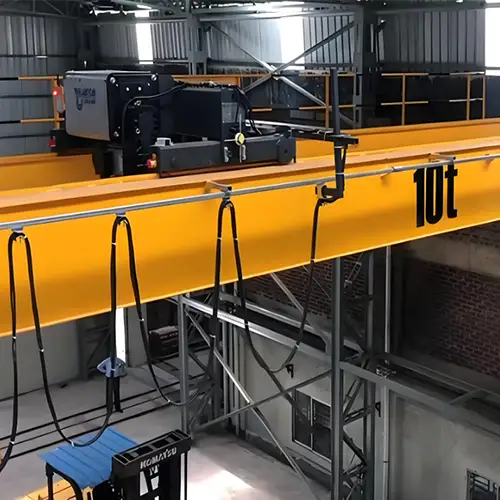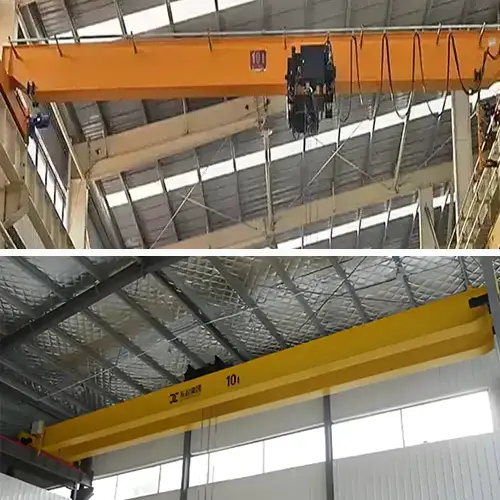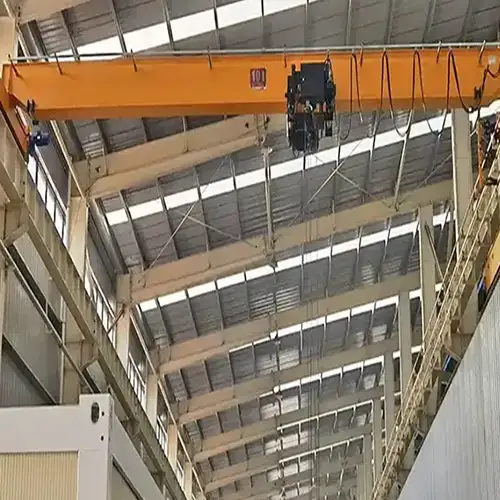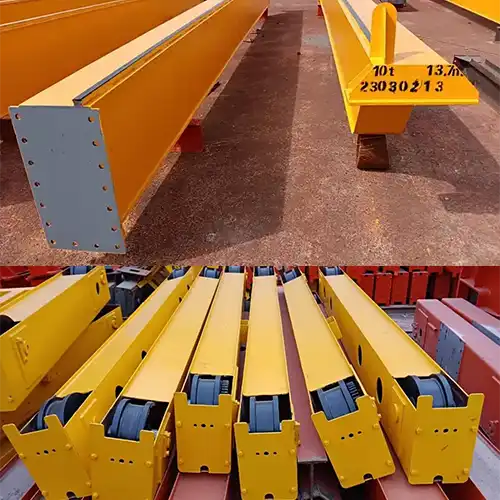10 Ton Overhead Crane for Sale: 5 Cases, 5 Bridge Crane Designs
Explore five different cases of 10 ton overhead cranes, featuring single and double girder designs, tailored for diverse industrial applications and needs.
Category: 10 Ton Overhead Crane
Your Trusted 10 Ton Overhead Crane Manufacturer & Supplier
10 Ton Overhead Crane for Sale, Custom Eot Crane Projects
5 Different Crane Cases, 5 Different Types of 10 Ton Bridge Crane Designs
Explore five different cases of 10 ton overhead cranes, featuring single and double girder designs, tailored for diverse industrial applications and needs.
When it comes to material handling and lifting solutions, a 10-ton overhead crane offers an optimal balance of strength, versatility, and efficiency. Here, we explore five different cases of 10-ton bridge crane designs, each tailored to meet specific operational needs. Whether you require a single girder or double girder crane, top running design, or low headroom solution, there's a crane configuration to match your requirements.

Case 1: HD Type 10 Ton Overhead Crane Design
Design and Features:
- Top Running Single Girder: The HD type is a top running single girder crane, designed for efficiency and versatility in material handling.
- European Style: Incorporates advanced European technology for enhanced performance and safety.
- Low Headroom: Designed to maximize hook height and optimize space utilization, especially in facilities with limited headroom.
Applications:
- Light to Medium Duty Operations: Suitable for general manufacturing, warehouses, and assembly lines.
- Precision Handling: Ideal for applications requiring precise and efficient load handling.
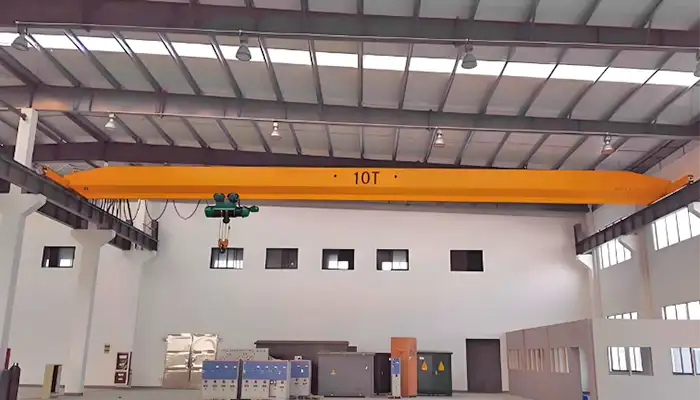
2. Single Girder Overhead Crane 10 Ton- Economical Design
Case 2: LD Type 10 Ton Overhead Crane Design
Design and Features:
- Economical Single Girder: The LD type crane is a cost-effective solution, utilizing a single girder and CD/MD wire rope hoist.
- CD/MD Wire Rope Hoist: Offers reliable and straightforward lifting mechanisms, suitable for various industrial applications.
- Top Running Configuration: Ensures efficient space usage and easy installation.
Applications:
- General Industrial Use: Perfect for light manufacturing, maintenance workshops, and storage facilities.
- Cost-Sensitive Projects: Ideal for projects requiring reliable performance without high initial costs.

3. Double Girder Overhead Crane 10 Ton- Top Running Design
Case 3: LH Type 10 Ton Overhead Crane Design
Design and Features:
- Double Girder Structure: The LH type crane features a robust double girder design, providing increased stability and load capacity.
- Top Running Wire Rope Hoist: Equipped with a top running wire rope hoist for efficient and safe load handling.
- Enhanced Lifting Height: The double girder design allows for higher lifting heights and improved hook coverage.
Applications:
- Heavy Duty Operations: Suitable for heavy manufacturing, steel mills, and foundries.
- High Precision Needs: Ideal for industries requiring precise positioning of heavy loads.

4. Double Girder Overhead Crane 10 Ton for Sale Bangladesh - Low Headroom and European Style
Case 4: NLH Type 10 Ton Overhead Bridge Crane Design
Design and Features:
- Double Girder, Low Headroom: The NLH type combines a double girder structure with a low headroom design, maximizing space efficiency.
- European Style: Incorporates advanced European technology for superior performance and safety.
- Top Running Configuration: Ensures optimal load distribution and stability.
Applications:
- Modern Industrial Facilities: Perfect for high-tech manufacturing, aerospace, and automotive industries.
- Space-Constrained Environments: Suitable for facilities with low ceilings or restricted headroom.

5. Double Girder Overhead Crane 10 Ton- Open Winch Design for Steel Mill Project Video
Case 5: QD Type 10 Ton Overhead Crane Designs
Design and Features:
- Double Girder with Open Winch: The QD type crane features a double girder design with an open winch, providing exceptional lifting capabilities.
- Heavy Duty: Designed for maximum load capacity and durability in the most demanding environments.
- Top Running Configuration: Ensures efficient load handling and distribution.
Applications:
- Extreme Heavy Duty: Ideal for steel production, large-scale construction projects, and heavy equipment manufacturing.
- Precision and Power: Suitable for applications requiring both precise control and powerful lifting capabilities.
Choosing the right 10-ton overhead crane design depends on specific operational needs, space constraints, and budget considerations. Whether you require a single girder crane for light to medium-duty tasks, or a double girder crane for heavy-duty operations, there are versatile and efficient designs available. From economical LD types to advanced European-style HD and NLH types, each crane offers unique features to enhance productivity and safety in your material handling processes.
10 Ton Overhead Crane Designs: Features, Applications, and Considerations
10 ton overhead cranes are versatile and essential tools in various industrial sectors, offering robust solutions for heavy material handling. These cranes come in different designs, each suited to specific applications and operational environments. Below, we explore the main designs, features, applications, and considerations for selecting a 10 ton overhead crane.
Single Girder Overhead Cranes
Design and Features:
- Single Beam Structure: Comprises one main girder that supports the hoist and trolley. This design is typically lighter and more cost-effective than double girder cranes.
- Top Running or Under Running: The crane can either run on top of the runway beams (top running) or be suspended from the bottom of the runway beams (under running).
- Compact and Efficient: Ideal for spaces with low headroom, providing maximum hook height and efficient space utilization.
Applications:
- Light to Medium Duty Operations: Suitable for light to medium-duty lifting tasks in workshops, warehouses, and manufacturing plants.
- Flexible Material Handling: Efficient for loading, unloading, and moving materials over short to medium distances.
Double Girder Overhead Cranes
Design and Features:
- Dual Beam Structure: Consists of two parallel girders, offering greater stability and higher lifting capacities.
- Top Running Configuration: Typically, the trolley and hoist run on rails mounted on the top of the two girders.
- Enhanced Load Capacity: Provides increased load capacity and higher hook height compared to single girder cranes.
Applications:
- Heavy Duty Operations: Ideal for heavy-duty lifting tasks in steel mills, foundries, and large manufacturing facilities.
- Precise Material Handling: Suitable for applications requiring precise positioning and handling of heavy loads.
European Style Overhead Cranes
Design and Features:
- Advanced Technology: Incorporates advanced engineering and technology for enhanced performance, safety, and efficiency.
- Compact and Lightweight: Designed to be compact and lightweight, reducing the load on the building structure and maximizing hook height.
- Energy Efficient: Features energy-efficient components and systems, leading to lower operational costs.
Applications:
- High-Tech Industries: Preferred in industries such as aerospace, automotive, and high-tech manufacturing where precision and efficiency are crucial.
- Modern Facilities: Suitable for modern industrial facilities requiring advanced material handling solutions.
Considerations for Selecting a 10 Ton Overhead Crane
Operational Requirements:
- Load Capacity and Duty Cycle: Ensure the crane meets the required load capacity and duty cycle for your operations.
- Span and Lift Height: Consider the span (distance between the runway beams) and lift height to ensure the crane can effectively cover the required area.
Environmental Conditions:
- Indoor or Outdoor Use: Determine whether the crane will be used indoors or outdoors, as this will influence the design and protective features required.
- Temperature and Corrosive Environments: Consider environmental factors such as temperature extremes and exposure to corrosive materials, which may necessitate additional protections.
Safety and Compliance:
- Safety Features: Look for cranes with advanced safety features such as overload protection, emergency stop functions, and anti-sway systems.
- Regulatory Compliance: Ensure the crane complies with relevant industry standards and regulations for safety and performance.
Maintenance and Support:
- Ease of Maintenance: Choose a crane with easily accessible components for maintenance and repairs.
- Manufacturer Support: Consider the level of support and services offered by the manufacturer, including installation, training, and after-sales service.
10 ton overhead cranes are indispensable tools in various industries, offering versatile and robust solutions for material handling. Whether you choose a single girder, double girder, or European style crane, it's crucial to consider your specific operational requirements, environmental conditions, safety features, and maintenance needs. By selecting the right design and configuration, you can optimize your material handling processes, enhance productivity, and ensure safe and efficient operations.
How to Get Your 10 Ton Bridge Crane Design
Acquiring the right 10-ton bridge crane for your needs involves several key steps, from understanding your specific requirements to choosing the right supplier and ensuring proper installation. Here's a comprehensive guide on how to get your 10-ton bridge crane design.
1. Assess Your Operational Needs
Understand Your Requirements:
- Load Capacity: Confirm that a 10-ton capacity meets your operational needs.
- Span and Lift Height: Determine the span (distance between runway beams) and the required lifting height.
- Duty Cycle: Identify the frequency and duration of crane usage to determine the duty classification.
Evaluate Your Environment:
- Indoor or Outdoor Use: Specify if the crane will be used indoors or outdoors, as this affects the design and protective measures.
- Environmental Conditions: Consider temperature, humidity, and exposure to corrosive materials, which may require special features.
2. Choose the Appropriate Crane Design
Single Girder vs. Double Girder:
- Single Girder: Suitable for light to medium-duty tasks, cost-effective, and efficient for spaces with low headroom.
- Double Girder: Ideal for heavy-duty applications, offering higher lifting capacities and greater stability.
Crane Types:
- HD Type: Single girder, top running design with low headroom, suitable for precise handling and limited space.
- LD Type: Economical single girder crane with CD/MD wire rope hoist, perfect for general industrial use.
- LH Type: Double girder with top running wire rope hoist, offering enhanced lifting height for heavy-duty tasks.
- NLH Type: Double girder, low headroom with European style design, optimal for modern facilities with space constraints.
- QD Type: Double girder with an open winch, designed for extreme heavy-duty applications requiring precision and power.
3. Consult with a Crane Manufacturer or Supplier
Research and Select Reputable Suppliers:
- Look for manufacturers or suppliers with a strong track record and positive customer reviews.
- Ensure they offer the specific type of 10-ton bridge crane design you need.
Provide Detailed Specifications:
- Share your operational requirements and environmental conditions with the supplier.
- Discuss customization options to ensure the crane design meets all your needs.
Request a Proposal:
- Obtain a detailed proposal including design specifications, cost estimates, lead times, and warranty terms.
4. Review Design and Proposal
Evaluate the Design:
- Review the proposed crane design to ensure it meets all your operational and environmental requirements.
- Check for compliance with relevant industry standards and safety regulations.
Consider Cost and Value:
- Assess the overall cost, including initial investment, installation, and long-term maintenance.
- Consider the value offered by advanced features, such as energy efficiency, low maintenance, and enhanced safety.
5. Plan for Installation and Maintenance
Prepare for Installation:
- Coordinate with the supplier for a detailed installation plan.
- Ensure your facility is prepared for the installation, including any necessary structural modifications.
Training and Commissioning:
- Arrange for operator training to ensure safe and efficient crane operation.
- Oversee the commissioning process to verify that the crane is installed and functioning correctly.
Maintenance Plan:
- Develop a maintenance schedule to ensure the longevity and reliability of your crane.
- Consider a service contract with the supplier for regular inspections and prompt repairs.
Acquiring a 10-ton bridge crane design involves careful assessment of your operational needs, choosing the appropriate crane type, consulting with reputable suppliers, reviewing proposals, and planning for installation and maintenance. By following these steps, you can ensure that you get a crane that meets your requirements, enhances productivity, and operates safely and efficiently.
Main Projects
Related Products

Supplied three grab bucket crane kits to Indonesia, enhancing garbage handling efficiency with high load capacity and reliable performance.
Free consultation to Confirm Parameters & Specifications and Get
Latest Crane Price & Crane Rate.
- Types of overhead cranes : _______?
- Optional: Overhead travelling crane, goliath gantry crane,Slewing jib crane, Single girder or double girder crane,small portable crane or kbk crane, etc.
- Capacity of overhead crane: _______?
- Optional: 0.25ton, 0.5 ton, 1 ton, 2 ton, 3ton, 5 ton, 10 ton,15ton, 20ton, 25 ton, 30ton,35ton, up to 550ton, etc.
- Crane span & lifting height : _______?
- Crane travelling length : _____?
- Control of overhead crane:_______?
- Optional: pendant/ remote/cabin control
- Voltage supply of overhead crane:_____?
- Eg,: 380V50/60HZ,3Phase or others,etc.
- Application/usage of crane:_______?
- Eg,: Steel mill, ,injection mold, cement,stone, concrete,granite, general manufacturing, etc.
Just leave a message via the contact form and our hoist and crane engineer will contact you with in 24working hours.
Get In Touch





